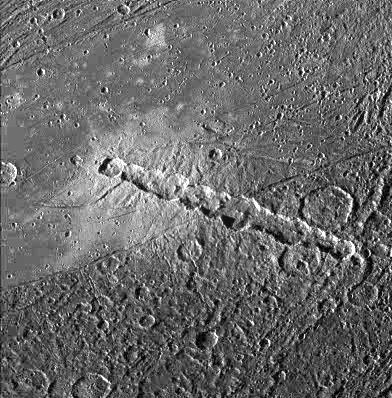Ficheiro:Chain of impact craters on Ganymede.jpg
Chain_of_impact_craters_on_Ganymede.jpg (392 × 398 píxeles; tamaño do ficheiro: 51 kB; tipo MIME: image/jpeg)
Historial do ficheiro
Prema nunha data/hora para ver o ficheiro tal e como estaba nese momento.
| Data/Hora | Miniatura | Dimensións | Usuario | Comentario | |
|---|---|---|---|---|---|
| actual | 21 de xullo de 2006 ás 20:14 |  | 392 × 398 (51 kB) | Peter439 | {{Information |Description=A chain of craters on Jupiter's moon Ganymede, probably caused by the impact of a fragmented comet. The picture covers an area about 120 miles wide. |Source= from http://antwrp.gsfc.nasa.gov/apod/ap011215.html |Date=1994 |Author |
Uso do ficheiro
A seguinte páxina usa este ficheiro:
Uso global do ficheiro
Os seguintes wikis empregan esta imaxe:
- Uso en be.wikipedia.org
- Uso en ca.wikipedia.org
- Uso en cs.wikipedia.org
- Uso en da.wikipedia.org
- Uso en de.wikipedia.org
- Uso en en.wikipedia.org
- Uso en en.wikiversity.org
- Draft:Original research/Radiation astronomy
- User:Marshallsumter/Keynote lectures (draft)/Meteor radiation astronomy
- Solar System, technical/Ganymede
- User:Marshallsumter/Rocks/Rocky objects/Ganymede
- Object astronomy
- Portal:Radiation astronomy/Lecture
- Portal:Radiation astronomy/Lecture/3
- Radiation/Astronomy
- User:Marshallsumter/Radiation astronomy/Craters
- Uso en es.wikipedia.org
- Uso en eu.wikipedia.org
- Uso en fi.wikipedia.org
- Uso en fr.wikipedia.org
- Uso en fr.wikibooks.org
- Uso en fr.wiktionary.org
- Uso en he.wikipedia.org
- Uso en hr.wikipedia.org
- Uso en it.wikipedia.org
- Uso en ko.wikipedia.org
Ollar o uso global deste ficheiro.



